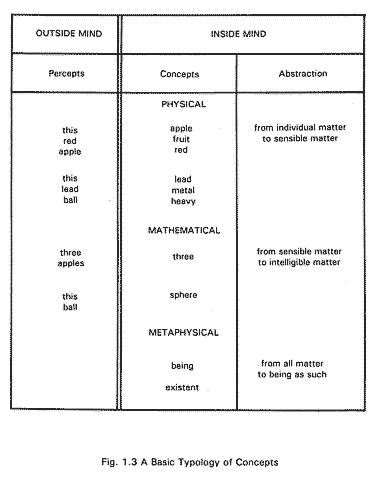STUDY MATERIALS: The Philosophy of Nature
Rev. William A. Wallace, O.P.
Terms of Use. Catholic Thinkers media is copyrighted material. However, we have made it free with the expectation that it will be shared and used by many. If you share what you see here, please acknowledge your source, and send people our way to find more. You or your organization may not benefit financially from use of our media without written consent. Please continue reading for full terms of use, and contact us with questions or requests: info@catholicthinkers.org
Lesson 1: Fundamental Concepts
"Modeling" = The Modeling of Nature (Catholic Univ. Press, 1996), Page Nos.;
"Elements" = The Elements of Philosophy (Alba House, 1977), Sec. Nos.
Readings
Modeling -- pp. 118-126 on knowledge, sensation, perception; pp. 131-139 on concepts; pp. 170-173 on sciences; pp. 300-308 on the demonstrative regress
Elements -- sec. 2 on logic; sec. 8 on predicables; sec. 9 on categories; sec. 12 on demonstration; sec. 13 on science; sec. 37 on epistemology; sec. 38 on knowledge.
Questions
1. How would you define knowledge? sense knowledge? intellectual knowledge?
2. What is the difference between a percept and a concept?
3. What is the difference between a real concept and a logical concept?
4. How does natural philosophy differ from mathematics? from metaphysics?
5. How do the concerns of the natural philosopher differ from those of the modern scientist?
6. Identify the two types of demonstration that are involved in the demonstrative regress.
Lesson 1 Figures:
Lesson 2: Nature - The Inner Dimension
Readings
Modeling -- pp. 3-7 on causality; pp. 7-18 on the four causes in nature; pp. 22-31 on the inner dimension, the individual natural body
Elements -- sec. 15 on philosophy of nature; sec. 16 on matter and form; sec. 17 on nature; sec. 34 on substance and accidents; sec. 35 on causality and its kinds.
Questions
1. How would you define natural form? protomatter?
2. Which is more intelligible, natural form or protomatter? Explain.
3. Identify three different meanings of end or final cause.
4. Explain why a thing's nature can be called its "inner dimension."
5. Enumerate the basic constituents of an individual natural body.
6. Give three examples each of substances and accidents that are found in the order of nature.
Lesson 2 Figures:
Lesson 3: Nature's Powers and Natural Kinds
Readings
Modeling -- pp. 31-34 on modeling various natures; pp. 134-135 on human cognitive powers; pp. 180-185 on human powers in operation; pp. 38-45 on the elements; pp. 45-73 on modeling inorganic natures.
Elements -- sec. 24 on sensation and perception; sec. 25 on intellection; secs. 26-27 on appetition and sensitive appetites; sec. 28 on volition; sec. 29 on man; sec. 22 on life and soul.
Questions
1. Identify the basic powers found in human nature. How may they be represented in a stimulus-response model?
2. How are protomatter and natural form represented in the powers model of an inorganic nature?
3. Compare the Aristotelian model of an inorganic nature with that of the modern physicist.
4. How can the Bohr model of the atom cast light on the function of the natural form in inorganic processes?
5. Contrast the modern chemist's explanation of chemical combination with that of the natural philosopher.
6. Contrast the modern physicist's explanation of radioactivity with that of the natural philosopher.
Lesson 3 Figures:
Lesson 4: Nature's Property - Motion or Change
Readings
Modeling -- pp. 76-97 on plant natures and their activities; pp. 97-113 on animal natures and their activities.
Elements -- sec. 18 on motion; sec. 66 on philosophy of science; sec. 67 on methodological concepts; sec. 68 on physical sciences.
Questions
1. How are the activities of plants and animals different from those of inorganic natures?
2. What different meanings are assigned to the terms "motion" or "change" in natural philosophy?
3. What is Aristotle's first definition of motion?
4. Apply the elements of this definition to the heating of water.
5. How is Aristotle's first definition of motion related to his second definition of motion?
6. How does Aristotle define action and reception, and how are both related to motion?
Lesson 4 Figures:
Lesson 5: Nature's Measures - Place and Time
Readings
Modeling -- p. 29 and 62 on quantity as individuating; pp. 29, 136, and 240 on continuous quantity; pp. 239-244 on measurement and metrical concepts.
Elements -- sec. 19 on place and time; sec. 63 on the philosophy of mathematics; sec. 64 on number and the continuum.
Questions
1. What is Aristotle's definition of place?
2. In this definition, to what does the expression "primary motionless" refer, in Aristotle's world and in our present universe?
3. What is the concept of space? Is there such a thing as empty space?
4. Explain Aristotle's definition of time and its relationship to motion.
5. Why are time and motion referred to as "flowing continuums"?
6. How can time and motion be said to exist?
Lesson 5 Figures:
Lesson 6: Nature's First Unmoved Mover
Readings
Modeling -- pp. 359-363, 406-409 on Newton on the nature and cause of gravity.
Elements -- sec. 20 on the First Unmoved Mover; sec. 41 on natural theology; sec. 43 on proofs of God's existence; sec. 47 on divine causality.
Questions
1. What is the basic structure of Aquinas's proofs of God's existence?
2. Outline the elements of Aquinas's "first proof," the prima via.
3. What is the motor causality principle?
4. In his commentary on the Physics, Aquinas offers a demonstration of this principle. Is it based on efficient or material causality? Explain your answer.
5. Give three examples of how the principle can be verified when applied to movers in local motion.
6. What is Aquinas's objection from nature to his proofs of God's existence, and what is his final resolution of the difficulty?
Lesson 6 Figures:
Study materials © 2021 International Catholic University





